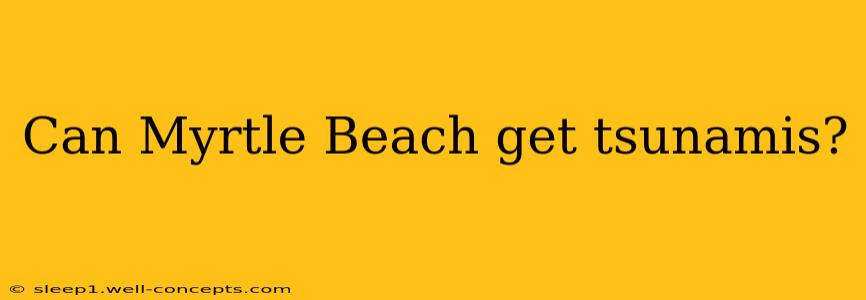Myrtle Beach, a popular coastal destination in South Carolina, enjoys a reputation for its beautiful beaches and vibrant atmosphere. However, the question of whether it's vulnerable to tsunamis is a valid concern for residents and visitors alike. While the likelihood of a devastating tsunami hitting Myrtle Beach is relatively low compared to regions situated along the Pacific Ring of Fire, the possibility cannot be entirely dismissed. This article explores the factors influencing tsunami risk in Myrtle Beach and provides a balanced perspective on the threat.
Understanding Tsunami Formation and Propagation
Tsunamis are typically generated by underwater disturbances, most commonly:
- Subduction Zone Earthquakes: These powerful earthquakes, occurring where tectonic plates collide, displace massive amounts of water, creating the destructive waves characteristic of tsunamis. The majority of devastating tsunamis originate from these events.
- Undersea Landslides: Large-scale underwater landslides, often triggered by earthquakes, can also generate tsunamis. The volume of displaced water creates significant waves.
- Volcanic Eruptions: Submarine volcanic eruptions, especially explosive ones, can displace enough water to produce tsunamis. The impact is often localized.
Myrtle Beach's Geographic Location and Tsunami Risk
Myrtle Beach sits on the Atlantic coast of the United States, significantly distant from the major subduction zones responsible for the world's most powerful tsunamis. The nearest significant subduction zone is located in the Caribbean, considerably far from the South Carolina coastline. This geographic distance greatly reduces the likelihood of a large-scale tsunami event directly impacting the area.
Local Factors Influencing Tsunami Impact
While the probability of a major tsunami is relatively low, other factors could still impact the severity of any wave generated:
- Coastal Topography: The shape of the coastline and the presence of shallow water areas can influence the size and speed of incoming waves. While Myrtle Beach has a relatively gradual slope in many areas, some sections may be more susceptible to wave amplification.
- Storm Surge: Strong hurricanes and nor'easters can produce significant storm surges that might be mistakenly perceived as tsunamis. The combined effect of a minor tsunami and a storm surge could exacerbate coastal flooding.
Historical Data and Tsunami Warnings
While there's no documented history of significant tsunamis directly impacting Myrtle Beach, the region is under the monitoring of the National Oceanic and Atmospheric Administration (NOAA). NOAA's sophisticated tsunami warning system provides early detection and alerts in the event of any potential threat, allowing for timely evacuations and emergency response.
Conclusion: A Balanced Perspective on Tsunami Risk in Myrtle Beach
The risk of a major tsunami directly impacting Myrtle Beach is relatively low compared to other coastal regions globally. The significant distance from major subduction zones and the effectiveness of NOAA's warning system contribute to a reduced risk profile. However, it's crucial to remain aware of the possibility and to understand the potential impact of lesser events or the compounding effect of storm surge and a minor tsunami. Staying informed about local emergency plans and heeding warnings issued by authorities is crucial for ensuring safety.
This article provides a comprehensive overview based on current scientific understanding and publicly available information. It's always advisable to refer to official sources for the most up-to-date information on coastal hazards and emergency preparedness.

